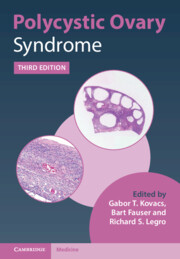Book contents
- Polycystic Ovary Syndrome
- Polycystic Ovary Syndrome
- Copyright page
- Contents
- Contributors
- Chapter 1 Introduction to and History of Polycystic Ovary Syndrome
- Chapter 2 Polycystic Ovary Syndrome: From Phenotype to Genotype
- Chapter 3 The Epidemiology of Polycystic Ovary Syndrome
- Chapter 4 Ovarian Ultrasonography in Polycystic Ovary Syndrome
- Chapter 5 The Classification of Polycystic Ovary Syndrome Informed by the International Guideline 2018
- Chapter 6 The Relevance of the Anti-Müllerian Hormone in Polycystic Ovary Syndrome Diagnosis and Management
- Chapter 7 Origins of Polycystic Ovary Syndrome In Utero
- Chapter 8 Adrenal and Polycystic Ovary Syndrome
- Chapter 9 Polycystic Ovary Syndrome and Environmental Toxins
- Chapter 10 Lifestyle in Polycystic Ovary Syndrome
- Chapter 11 Ovulation Induction in Polycystic Ovary Syndrome
- Chapter 12 Ovarian Surgery for Ovulation Induction
- Chapter 13 In Vitro Fertilization and Assisted Reproductive Technologies in Polycystic Ovary Syndrome
- Chapter 14 Pregnancy Complications and Children Outcomes in Patients with Polycystic Ovarian Syndrome
- Chapter 15 The Role of In Vitro Maturation in Polycystic Ovary Syndrome
- Chapter 16 The Treatment of Obesity in Polycystic Ovary Syndrome
- Chapter 17 Mood Disorders in Polycystic Ovary Syndrome
- Chapter 18 The Long-Term Health Consequences of Polycystic Ovary Syndrome
- Chapter 19 Polycystic Ovary Syndrome
- Chapter 20 Cancer and Polycystic Ovary Syndrome
- Index
- References
Chapter 16 - The Treatment of Obesity in Polycystic Ovary Syndrome
Published online by Cambridge University Press: 13 May 2022
- Polycystic Ovary Syndrome
- Polycystic Ovary Syndrome
- Copyright page
- Contents
- Contributors
- Chapter 1 Introduction to and History of Polycystic Ovary Syndrome
- Chapter 2 Polycystic Ovary Syndrome: From Phenotype to Genotype
- Chapter 3 The Epidemiology of Polycystic Ovary Syndrome
- Chapter 4 Ovarian Ultrasonography in Polycystic Ovary Syndrome
- Chapter 5 The Classification of Polycystic Ovary Syndrome Informed by the International Guideline 2018
- Chapter 6 The Relevance of the Anti-Müllerian Hormone in Polycystic Ovary Syndrome Diagnosis and Management
- Chapter 7 Origins of Polycystic Ovary Syndrome In Utero
- Chapter 8 Adrenal and Polycystic Ovary Syndrome
- Chapter 9 Polycystic Ovary Syndrome and Environmental Toxins
- Chapter 10 Lifestyle in Polycystic Ovary Syndrome
- Chapter 11 Ovulation Induction in Polycystic Ovary Syndrome
- Chapter 12 Ovarian Surgery for Ovulation Induction
- Chapter 13 In Vitro Fertilization and Assisted Reproductive Technologies in Polycystic Ovary Syndrome
- Chapter 14 Pregnancy Complications and Children Outcomes in Patients with Polycystic Ovarian Syndrome
- Chapter 15 The Role of In Vitro Maturation in Polycystic Ovary Syndrome
- Chapter 16 The Treatment of Obesity in Polycystic Ovary Syndrome
- Chapter 17 Mood Disorders in Polycystic Ovary Syndrome
- Chapter 18 The Long-Term Health Consequences of Polycystic Ovary Syndrome
- Chapter 19 Polycystic Ovary Syndrome
- Chapter 20 Cancer and Polycystic Ovary Syndrome
- Index
- References
Summary
Obesity is commonly associated with polycystic ovarian syndrome (PCOS), featuring both elements of insulin resistance and metabolic syndrome. Understanding the causes of obesity, its impact on health and its comorbidities, as well as its regulation, are important factors in relation to the treatment of obesity and more particularly the effect of weight loss in PCOS. The various modalities of treatment include the conservative approach, utilizing lifestyle and dietary techniques, pharmacotherapy and the more invasive surgical approach, which has been shown to have better weight-loss results and less recidivism.
Keywords
- Type
- Chapter
- Information
- Polycystic Ovary Syndrome , pp. 150 - 161Publisher: Cambridge University PressPrint publication year: 2022



